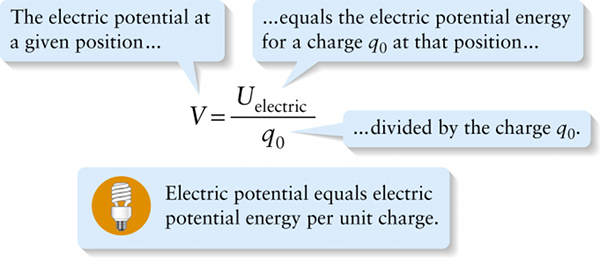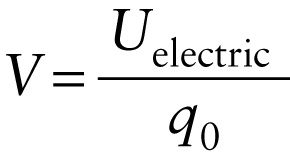Electric potential related to electric potential energy (17-5)
Question
…divided by the charge \(q_0\).
{"title":"The electric potential at a given position...","description":"Incorrect","type":"incorrect","color":"#99CCFF","code":"[{\"shape\":\"poly\",\"coords\":\"82,133\"},{\"shape\":\"rect\",\"coords\":\"10,16,12,16\"},{\"shape\":\"poly\",\"coords\":\"144,22\"},{\"shape\":\"rect\",\"coords\":\"3,46,48,98\"}]"} {"title":"…equals the electric potential energy for a charge q sub 0 at that position…","description":"Wrong","type":"incorrect","color":"#ffcc00","code":"[{\"shape\":\"rect\",\"coords\":\"111,7,154,52\"}]"} {"title":"…divided by the charge q sub 0.","description":"Correct!","type":"correct","color":"#333300","code":"[{\"shape\":\"rect\",\"coords\":\"227,24,228,24\"},{\"shape\":\"rect\",\"coords\":\"163,104,201,149\"}]"}Review
Our discussion in Section 17-2 shows that if a point charge \(q\) changes position, the potential energy change \(U_{\mathrm{electric}}\) depends on both the magnitude and the sign (positive or negative) of \(q\) (see Figure 17-3). We can simplify things by considering the potential energy per charge—that is, the electric potential energy for a charge at a given position divided by the value of that charge. We call this quantity the electric potential and denote it by the symbol \(V\):

We call the charge \(q_0\) the test charge: Its charge has such a small magnitude that it doesn’t affect the other charges that create the electric field in which \(q_0\) moves. Because we divide out the value of \(q_0\), the value of the potential \(V\) at a given position does not depend on the value of the point charge \(q_0\) that we place there. Instead, \(V\) is determined by the other charges that produce the electric field at the position where we place the test charge.
